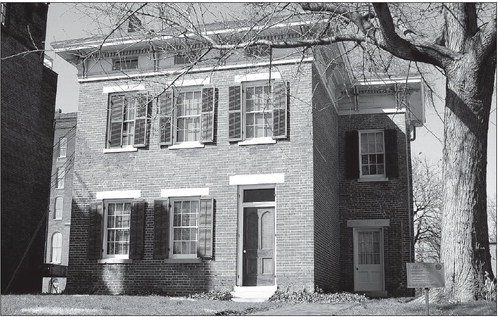Eells House connects town with Underground Railroad

On Aug. 21, 1842, Dr. Richard Eells heard another knock at his back door. This time it was Charley standing there, his clothes still wet from his swim across the Mississippi River.
A few days earlier, the slave had run away from his owner, Chauncey Durkey of Monticello, Mo. Dr. Eells had to act quickly, for he knew the slave catchers would be coming soon. Eells told Charley to wait for him in the carriage house. Eells then ran upstairs to his bedroom to get dry clothes for Charley.
Quincy was Stop Number One on the northern route of the Underground Railroad out of Missouri. From Quincy, slaves were quickly and secretly moved from one “station” (hiding place) to another, heading north and east to Chicago and eventually Canada, where slavery was no longer permitted. All “conductors” who helped the slaves go from one station to the next risked their own freedom and fortune, for aiding an escaped slave was breaking federal law.
Eells knew he could not hide Charley in his home at 415 Jersey. Just across the river lay Missouri, a slave state. At this time it was legal for slave catchers to leave their state and enter a free state (Illinois) to capture runaway slaves. The doctor had long been associated with the abolition movement in Illinois. In 1839 he had been elected as president of the Adams County Anti-slavery Society. In 1843 he would be elected president of the state anti-slavery society. His home would be the first place the slave catchers would look for the runaway slave.
Charley changed into the dry clothes while Eells prepared the carriage. They then headed east toward present-day 24th Street. The carriage turned north along the cemetery (today’s Madison Park), apparently headed to the Mission Institute near 25th and Maine. The Mission Institute was run by Dr. David Nelson who trained Christian missionaries there.
At night it was a meeting place for abolitionists. Slave catchers were already near the area watching for the runaway. They saw the carriage of Dr. Eells approach, and saw Charley lift his head from beneath a buffalo robe. The men tried to stop the carriage, but to no avail. Charley jumped out of the carriage and ran across the cemetery. He was captured later that night and turned over to the brother of Chauncey Durkey. Dr. Eells swiftly turned his carriage around and returned home. Sadly, we know nothing more of what happened to Charley.
The Quincy Whig of Saturday, Aug. 27, 1842 reported: “The second day after the occurrences alluded to above – which was Tuesday last – a warrant was issued for the apprehension of Dr. Richard Eells – an old and respectable physician of this city, a well known abolitionist; in fact, one of the principal head men of this misguided sect in this county, and one of their candidates for the Legislature at the late election, on the charge of harboring, secreting, and assisting the slave spoken of to run away from his lawful owner.”
Dr. Eells was released on bail and was to appear at the Circuit Court the next month. When his wife became ill, Dr. Eells requested that the trial be delayed. The state of Missouri, under Gov. Thomas Reynolds, requested that Eells be tried in Missouri, a dangerous situation for any abolitionist, to be tried in a slave state. Eells then used the Underground Railroad himself to go to the Chicago area for a while. In January 1843, Gov. Ford of Illinois signed the extradition order, to send Eells to be tried in Missouri, but because of so much abolitionist pressure within his own state, he rescinded the order in February 1843. Eells returned to Quincy. In April, 1843, Judge Stephen A. Douglas found Dr. Eells guilty and fined him $400. The case was to be appealed to the Illinois State Supreme Court. In February 1844, the State Supreme Court upheld the lower court’s ruling, with three justices dissenting.
Dr. Eells died on a steamboat near Cincinnati, Ohio, on Oct. 4, 1846. Abolitionists appealed the case to the United States Supreme Court in an attempt to end slavery. The executors of the Eells estate were represented by Salmon P. Chase and William Seward (later secretaries of the treasury and state respectively in the Lincoln administration). In 1852, the U.S. Supreme Court upheld the Illinois State Supreme Court’s rulings.
This is the first case from Quincy that went to the United States Supreme Court. A copy of the Supreme Court case can be seen at the Eells house today and on the Historical Society’s website.
Because of its significance to the history of the Underground Railroad, and because all the information is documented in the county, state, and federal courts, the National Park Service has designated the Dr. Richard Eells House at 415 Jersey, Quincy, an official Historic Underground Railroad Site.
The Friends of the Dr. Richard Eells House maintain the building, Quincy’s oldest brick building built in 1835, and have furnished it as it might have looked in the 1840s.
The house is open on Saturdays from 1 p.m. to 4 p.m. from February through November. Tours may be arranged by calling (217) 223-1800.
Patrick McGinley is a retired educator from Quincy Public Schools and John Wood Community College. He has served on the board of the Friends of Dr. Richard Eells House and is currently the secretary of the board of the Historical Society.
Sources
Quincy Whig, Aug. 27, 1842.
Quincy Whig, Feb. 8, 1843.
Quincy Whig, April 26, 1843.
Quincy Whig, May 3, 1843.
"The Dr. Richard Eells House." Pamphlet, The Friends of Dr. Richard Eells House






